Sorties-Cinema - The Florida Project : The new Sean Baker’s film
Par Mulder, 14 septembre 2017
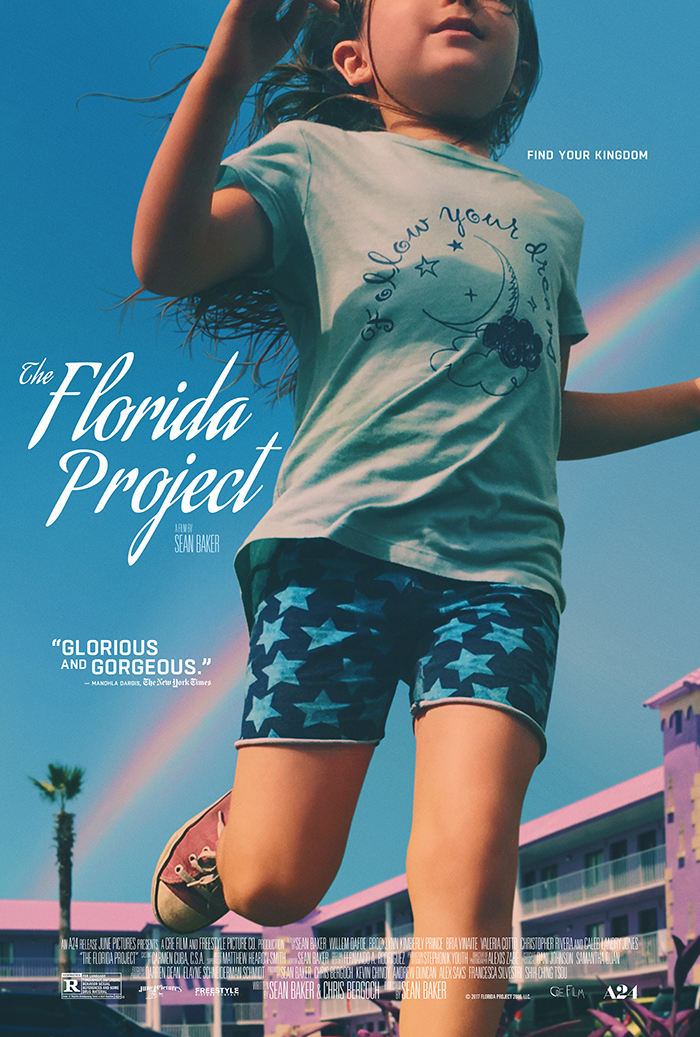
The Florida Project is a 2017 American drama film directed by Sean Baker, from a screenplay by Baker and Chris Bergoch. It stars Willem Dafoe, Brooklynn Kimberly Prince, Bria Vinaite, Valeria Cotto, Christopher Rivera and Caleb Landry Jones. It was screened in the Directors' Fortnight section at the 2017 Cannes Film Festival. It is scheduled to be released in a limited release on October 6, 2017, by A24.
In a $35-a-night, Orlando motel, under an electric orange sun, in the unreachable shadow of Walt Disney’s lavishly imagined American utopia, six year-old Moonee – brave, wild-hearted and possessed of irrepressible mischief – conjures up out of almost nothing her own realm of magic and wonder. Her mother, Halley, can barely keep the two of them from the brink of disaster. But along with her ruffian friends Jancey and Scooty, Moonee does what any child would: she turns her world into the stuff of never-ending, spellbinding adventures, and runs full speed towards the future regardless of her predicament.
Writer/director Sean Baker invites audiences to see Moonee’s motel world as she does: a fizzy, candy-colored dreamscape full of laughter, love, surprises and everyday pranks and heroes, one that reminds us of how even the toughest of times are uplifted by the brash innocence of childhood. The film, too, is woven of contrasts. Baker pairs non-actors with actors, mixes florid 35mm cinematography with digital verité, and places striving adult characters against a pint-sized, in-yourface heroine who explodes with optimism and gutsiness.
Moonee may be the reverse of a perfectly charmed fairy-tale princess, but she exuberantly takes life for all it’s worth. The result is a film about girlhood, about constructed families and about defiance of hard times that breaks all the rules for films about such things. At the core of it all is a humanity that can evoke concern for the characters but equally hilarity, tenderness and hope for what might come. Just as Walt Disney in 1965 dubbed his plans to acquire the land for Disney World “The Florida Project,” so too does Baker use that title. Its suggestion of something aspirational yet provisional seemed a match with this tale of a Florida child forging into an unwritten future one summer escapade at a time. Says Baker: “I want viewers to laugh with, love and embrace Moonee, her friends Jancey and Scooty, Halley, and Bobby – and I hope that the connection with the characters will last long after the theater experience.”
The rapturous chaos and scrappy resilience of childhood has long called out to filmmakers to crack its visual code. In the 20s and 30s, even before sound, Hal Roach first turned the devil-may-care spontaneity of Depression-era street kids into comic gold with the endlessly influential Our Gang series. From Truffaut’s The 400 Blows to Ken Loach’s Kes, the trials and mischief of childhood have become an exhilarating lens on the modern world. The 21st Century has seen such disparate takes as Bruno Dumont’s tragicomic L’il Quinquin, Benh Zeitlin’s fable Beasts of the Southern Wild and Richard Linklater’s timecompacting
Boyhood.
The Florida Project brings its own fresh-squeezed view of childhood on the edge, one that’s not a dark descent but a beautiful, comedic uprising full of screaming colors and a manic summer vibe. But if Baker’s style compels with a hyper-reality, his characters are wrenchingly real. Tiny Moonee, who summons her own empowering kingdom from a motel strip, is caught in a phenomenon that boomed when the housing market went bust in 2008: budget motels transformed into semi-permanent shelters for those unable to rent. Surreally, this phenomenon also rooted itself outside the gates of the two most iconic symbols of childhood fantasy and visions of tomorrow: Disneyland and Disney World. In Anaheim and Orlando, Mid Century motels simulating rockets, castles and pirate ships in liplicking shades of strawberry and pistachio became home to working families and their kids – who took their strange abodes in stride.
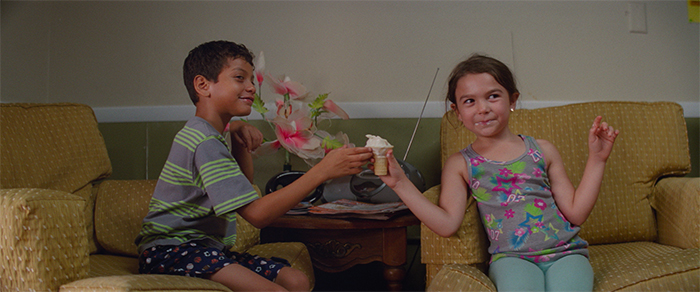
The sight of boisterous tykes living in whimsical Florida motels first struck The Florida Project’s co-screenwriter Chris Bergoch in 2011. His mother had just relocated to Kissimmee, Florida, which for Bergoch meant regular drives down Central Florida’s motel-lined Route 192. On one such drive, he called up his friend and writing partner—indie filmmaker Sean Baker – and started describing what he saw. Both felt compelled to dig deeper. Indeed, that first conversation would spark a journey that would soon become far more than an idea for a film about childhood’s beauty and bravado – it would become a united community effort to get the stories of these unseen families out into the culture in a vibrant way. “Every time I returned to Orlando, I'd pass the motels and the heartbreak of it never went away. Over time, the situation only grew and the need to tell this story did as well,” says Bergoch.
Baker says: “When Chris first brought the situation to my attention I was taken aback. Families come from all over the world to experience ‘The Most Magical Place on Earth,’ yet for many, life in its shadow is about struggle, heartache and insecurity. It’s a place dedicated to the joy of being a child, yet there are thousands of children watching from the sidelines. That led us to want to tell one oftheir stories.”
It was also a story right up Baker’s alley. His driving instinct as a writer and director is to illuminate lives that don’t usually come to the fore. “As a filmmaker, my interest is exploring and understanding our country’s current state and I felt this subject fell right in line with this journey,” Baker says. “And I’ve always wanted to make a film about childhood. Though many things would change, the idea of focusing primarily on a young girl living in a budget motel was the foundation from the beginning.”
Inspired as Baker and Bergoch were, the project took another five years to get off the ground. Meanwhile, Baker’s career abruptly ignited with two inventive, microbudget indies that announced the arrival of a new voice. With Starlet and the iPhone-shot Tangerine, Baker splashed light on unexplored sides of Los Angeles and introduced his neon-hued vision of 21st Century neorealism – merging the raw verité of real life focused on people you’ve never met before with a radically expressive yet light touch.
Even as Baker was coming to the fore, The Florida Project kept percolating. “At first we couldn’t secure financing for the film which is one of the reasons that Tangerine was made. But we continued to follow the situation in the Florida motels closely and we continued making trips to the area,” he says. “While there, we did our best to hear as much as we could from the voices of the community.” For Baker, listening to and especially including the local community is part-and-parcel of his filmmaking, as connected to the process of storytelling as the script or the camerawork. He explains: “We always begin these films in the same way, by asking folks from the community if they’re interested in becoming involved. We spoke to a lot families in the motels, as well as the management. We wanted to hear multiple points of view and absorb as much everyday detail as possible.”
He goes on: “I feel that focusing attention on the details is key to letting the audience suspend their disbelief. It was so important that the audience instantly believes the world we are presenting them and quickly joins along with Moonee and her friends on their summer adventures.” Though Bergoch and Baker wrote a formal script, Baker takes scripts as preliminary blueprints that can shift as the moment demands. In his approach, the writing process never stops until the final edit, and it is a collaboration with cast and crew, as well as with the authentic messiness of life (and in this case, kids’ natural shenanigans.) “We were already making significant changes to the script after the first week of shooting because we found ourselves inspired to go in another direction with certain characters. You can only have happy accidents if you allow for improvisation behind the camera. And I love happy accidents,” he muses.
The core of the story was always specifically anchored in Moonee’s endlessly creative use of her immediate environment, an environment of which she is both a product and a rebel. She gleefully drops four-letter words, panhandles to buy sugary treats and opens every forbidden door in the motel. But she does so in the spirit of going after everything with gusto, turning a life on the cusp of peril into one of positive glee. “We wanted the film to evoke at the power of a child’s imagination and sense of wonder,” says Baker. “Despite not being able to afford a ticket to the nearby theme parks, Moonee still finds her own fun and adventure. Moonee is able to go to her own safari by visiting the cow field behind the motel and her own haunted mansion by exploring an abandoned condominium.” That’s also why Baker imbued Moonee, her best friend Scooty and new friend Jancey with a contemporary Hal Roach vibe – filling their scenes with the bumptious, anarchic antics of scamps on the loose like a Little Rascals of the recent Great Recession. “The original Our Gang and Little Rascals series had a big influence on me and are part of why I make films,” Baker says. “I’ve always felt the series reached the pinnacle of what is possible with child performers, especially children giving comedic performances. Very few films have matched the authenticity and freshness of the series, even though it is nearly a century old.”
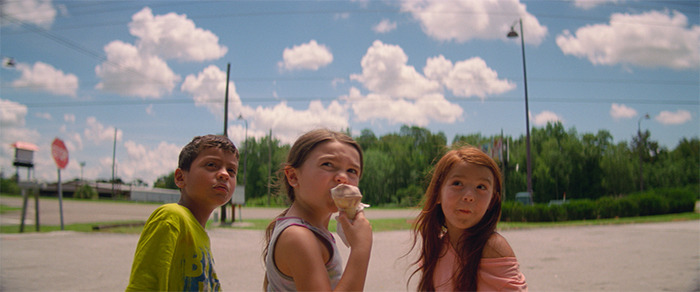
He goes on: “In some ways, I see The Florida Project as a modern day Little Rascals. Those films also had hard times as a backdrop but the main focus was the joy of the children’s adventures. The series was never sad or melancholy because the gang’s attitude was never sad or melancholy. I think that’s what helped us all connect with the children on a greater level. Revisiting and studying the series as an adult, I found this approach quite humanistic, focusing on the universality of youthful experience.” Baker always had a favorite Rascal: Spanky McFarland, the boisterous, cherub-faced schemer of the gang. “From the very start of thinking about The Florida Project I wanted to find today’s Spanky, someone talented and hilarious, and I believe we achieved that with Brooklynn Prince as Moonee.”
The reality, comedy and poignancy of The Florida Project all hinged from the start on unearthing a child who could embody the unusually layered persona of Moonee. But how do you find a six year-old capable of not only rendering a performance of comedic and dramatic dimensions, but who also can tap into real understanding for a kid making the most of life in a downtrodden motel? The search took off in 2016, as Baker, Bergoch and their fellow producers Shih-Ching Tsou and Kevin Chinoy held auditions for children from all over central Florida. “It didn’t matter if they had experience or not. We were just looking for fun and extroverted personalities,” Baker
describes. Amid the hundreds of kids Baker met was Brooklynn Prince, a Floridian who despite her diminutive size stood out as having the huge spirit of a force of nature. Rare for a kid at that still-forming age, she was able to respond to tough and strange situations with her own toughness, as well as laughter, imagination and creativity. Though she had previously acted in a few commercials and smaller roles, carrying a film as the lead was a completely unexpected experience, one Prince devoured.
“Brooklynn is simply one of the best actors – of any age – I’ve ever encountered,” says Baker. “She is intelligent far beyond her years, warm-hearted, positive and she loves acting. Her wonderful parents have provided a really strong support system for her. I’m so grateful that she came to audition for us, because we knew within moments she was the one who would be hard to beat out for the role.” Adds Bergoch: “Brooklynn was the exact same Moonee we’d seen in our heads for years, coming to life right before our eyes.”
Remarkably, Prince is almost the polar opposite of Moonee – grounded, reflective, impeccably well behaved – but was able to channel the character’s steely impishness and joyously insolent take on a world that hasn’t give her a lot. “She is transformative,” describes Baker, “and truly became Moonee as soon as I called ‘action.’ One would think she is typecast because of her age; however, Brooklynn is so very different from Moonee. Moonee’s brashness is a character trait that Brooklynn herself doesn’t embody.” Much of the drama of The Florida Project plays out in Prince’s physicality, gestures and roiling energy, which the camera can barely contain. Her face – alternately sassy, bemused and stoic – becomes a road map to how one transcends a world like the one where Moonee is growing up.
How does a six year-old accomplish all that? For Prince, it started with striving to walk in Moonee’s shoes. Says Prince: “I like Moonee. She’s very inventive and she likes taking her friends on adventures. And I think she’s also someone who is very funny, very loyal and sometimes very brave.”
Prince agrees that her life is nothing like the one Moonee is leading, but that only sparked her curiosity more. “I definitely don’t talk the way she does – if I did, I would get grounded!” she laughs. “I also don’t like maple syrup at all but Moonee loves it. I don’t tell people I have asthma to get ice cream. But mostly, I think I am luckier than Moonee.” It was Baker, says Prince, who helped her find the courage to follow Moonee into situations beyond anything she has known or certainly contemplated in her few years. “Being Moonee felt natural,” recalls Prince, “but sometimes we did scenes that were hard, especially at the end, and Sean would talk to me about how the scene was going to go and then he would make me feel a whole lot better.” “Sean is the kind of director who is never mean or tough,” she continues. “He’s very honest and he’s talkative and he would always say good job when I did a good job. He’s very funny, plus he loves Chihuahuas and I love Chihuahuas. I loved hanging out.
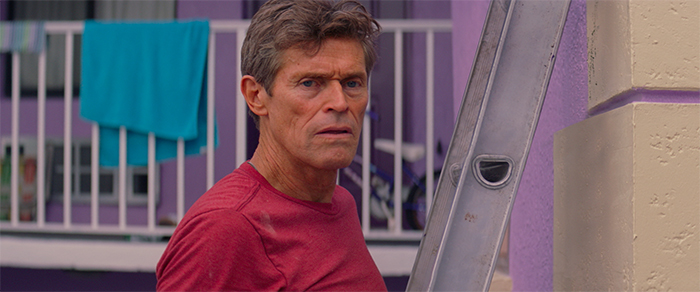
Prince especially bonded with her young co-stars, Valeria Cotto and Christopher Rivera, who come from backgrounds quite different from her own. Cotto, who plays Moonee’s increasingly inseparable new friend Jancey, is an example of the unconventional casting process Baker employs. “There is always a degree of street casting in my films and the discovery I’m most proud of on this film is Valeria. I saw her and her mother in a Kissimmee Target store one evening. Valeria caught my eye because of her vibrant red hair. I gave her mother my card and prayed she’d have her daughter audition,” recalls Baker. “She did and Valeria landed the role of Jancey. Since then, Brooklynn and Valeria have become best friends.”
Rivera brought in another layer of authenticity as a boy who was already growing up in one of the motels on Route 192. “Christopher’s an incredible young man, full of good humor and with a truly mischievous nature,” Baker describes. “He photographs beautifully and was also able to improvise. He was especially happy to be working with, as he called him, The Green Goblin – Mr. Willem Dafoe.” For Baker working with kids so young, yet so pure and fierce was one of the most exciting challenges of the film. Early on, he asked associate producer Samantha Quan to come on as acting coach for his young trio, and she carefully gave them just enough input for their young minds to latch onto with joy. “Samantha was wonderful with the kids and got them to a place where it made my job so easy,” says Baker. “They always knew their scripted lines but they were ready to try new things if I asked.” Of course, Baker was keenly aware he would be asking the kids to say and do normally prohibited things – but he was also fully committed to shielding them from too much. “Samantha and the parents of our cast were very clear with the kids that profanity was only to be used while shooting. It was important to me that the kids were never exposed to anything they didn’t have to be. It was also important to me that this was a positive, learning experience for the kids and we were very protective of them in that way.”
The force of the kids’ energy was an inspiration to all, though there was a constant balancing act to keep the mayhem just within control. Says Willem Dafoe: “I decided very early to let the kids’ anarchy fly. Sean is excellent at setting up situations and letting the action take the story where it organically goes, so the kids were for the most part just having fun -- I don’t think they ever even thought of it as work.”
Dafoe notes that the dynamism of the kids jibes with Baker’s in-the-moment style. “I suppose the most difficult thing with kids is that what you gain in spontaneity you lose in the inability to repeat and refine. So you have to be willing to capture things as they happen, because they can’t be reworked or recreated. Kids are naturally restless, carefree, so they became our guides,” he observes. “Rather than get rankled, I just ‘used’ it for Bobby, who loves the kids but also sometimes wants to strangle them.”
The next big mission was to find Moonee’s mom, Halley, who still has the libertine spirit of a child herself, yet loves her daughter with a characteristic ferocity. Once again, Baker conducted his search in a nonconventional way, finding 24 year-old Bria Vinaite on Instagram. Vinaite had no formal experience whatsoever, but what she did have was a strong, playful persona that leapt right off the internet.
“There were definitely temptations to go with a known actor for Halley and we knew it was rolling the dice to cast a first-timer,” Baker admits. “However I’m so happy I listened to my instincts regarding Bria. When I first came across her Instagram page, I was instantly intrigued. There was something very different that set Bria apart from the thousands of other Instagrammers. She didn’t take herself seriously. Hyper, carefree and extremely funny —she had all the same traits we had in mind for Halley.” When Vinaite got a message from Baker, she wasn’t at all sure what to make of it. “I have a lot of followers on Instagram but not enough to think that that something like this could happen,” she says. “So I get this message from Sean saying he’s a director and I look at his Instagram and it is literally just pictures of dogs. It doesn’t say filmmaker or anything … it’s just dogs. Mind you, I have
so many creepy people messaging me, so I’m thinking this guy’s just trying to prank me or he’s up to something weird.”
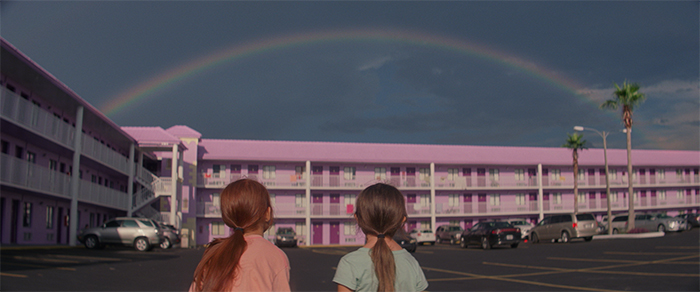
After looking Baker up on Google and seeing that everything checked out as legit, Vinaite decided to go for it. The next thing she knew she was flying to Florida. “When Sean told me I had the part, it was just the most surreal thing to ever happen to me,” she recalls. “I’m still to this day trying to process it!” One thing Vinaite wanted to capture more than anything else is how devoted Halley is to Moonee in her own way. She’s no perfect parent, and can’t provide even close to what she wishes she could, but she would do anything to try to keep them OK and together. “Sean really wanted me to be carefree and loose and have fun with this character but to also tap into Halley’s sense of anger and sacrifice,” explains Vinaite. Says Baker: “I think audiences will be able to see past Halley’s short-comings and see a parent who will do anything for her child and hopefully care for her no matter what. Bria brought such realism and truth to the character that I don’t see how that will not be the case. “
To help her prepare, Baker introduced Vinaite to several moms like Halley. “I listened to their stories and it truly showed me how real this situation Halley and Moonee are in is for people,” she says. “These women are going through an epic struggle every day, and I really appreciated the fact that they were so honest with me. It really hits you that even though these moms are struggling their kids are so happy and loved.”
Perhaps the biggest task for Vinaite was forging with Prince the same bouncy, BFF kind of link Halley has with Moonee. The two spent a lot of time together to foster that camaraderie. “Brooklynn was very, very open to building a relationship with me,” Vinaite says. “I think what really helped is that we both liked each other from day one. So that made it easy for us to have a very real relationship. On set, we just hung out together every day. We ate lunch together, we played Pokémon, we did everything together.” “Bria was an amazing friend,” adds Prince. “Every day she would give me a big hug first thing. Then we would Snapchat and send each other pics and I felt like we really bonded. We were like cake and icing.”
While Halley and Moonee teeter, however buoyantly, on the precipice every single day, the film’s grounding force is found in one of its most moving characters: Bobby, the Magic Castle motel manager. Bobby quietly and unassumingly makes a major difference in their lives simply by trying to do his next-to-impossible job with
some modicum of care, compassion and proficiency. Bobby would never think of himself even remotely as any sort of hero, but he nevertheless saves people every day in small ways.
The character is anchored in real lives. “Bobby came about as an amalgamation of a few motel managers that we met while in development,” Baker explains. “I noticed a common thread: a sincere caring for the tenants of their motels, even while trying to maintain a professional relationship with them. I also noticed that there was almost a reluctant parental figure in these managers – reluctant because they wanted to look after their residents, yet knew they might also be in the position of ‘evicting’ a family.” To cast Bobby, Baker switched gears, bringing in one of today’s most accomplished, versatile actors: Willem Dafoe. A two-time Academy Award® nominee, Dafoe is known for a sweeping range of roles from Jesus in The Last Temptation to The Green Goblin in the Spider-Man movies to Platoon, Shadow of the Vampire, Finding Nemo and Antichrist, to name just a smattering. He’d never
played anyone quite like Bobby though, and brought characteristic commitment to creating something indelible. “Willem came to town a week prior to shooting and began meeting some of the motel managers,” says Baker. “I feel he truly achieved that reluctant paternal attitude I was looking for. It’s incredibly subtle and that’s exactly what was needed. Willem has the ability to leave the audience wanting more in the best of ways, wanting to know more about this character, wanting to hear Bobby’s thoughts.” Dafoe has a knack for leaving space in his characters for the audience to connect with in their own ways, something he cultivates. “I don’t know what a role is until I’ve played it, and even then it’s for the audience to decide who the character is. I want to be and inhabit the character, not explain who he is,” he says.
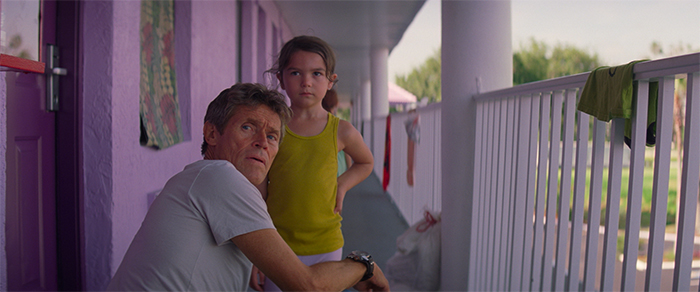
His take on Bobby is that of a working man doing his best, no matter his flaws. “I suppose he’s not an exceptional person but Bobby’s struggle to make the best of a lessthan- ideal environment was interesting to explore,” Dafoe comments. “It’s not a dramatic or romanticized heroism he brings, but the quiet everyday compassion of a flawed but decent person.” When Dafoe spent time with a real-life Florida motel manager, that view only deepened. “It was very fruitful,” he recalls. “I talked to him about his past, his feeling for his work, pumped him for details and anecdotes. From that meeting an image of Bobby started to form in my imagination and I could also concretely draw on his dress and manner.” He notes that the research had to be done with great sensitivity. “The residents of the motels are hoping for a better tomorrow and they really don’t want to talk about today or worse, the past. I wanted to respect their privacy. I didn’t want to swoop down as a Hollywood blood sucker.”
Nevertheless, what he took in was revelatory. “I learned many things but perhaps the most haunting was that almost every hotel resident I met seemed shocked that they were in the situation they were in. They live on a slippery slope and it’s so easy to fall through the cracks.” While a multiplicity of personal drives lie behind Bobby’s day-to-day maintenance, one in particular stands out: pride. “I think his pride in the motel is a key to his personality,” says Dafoe. “Bobby lives in the hotel, too; he’s part of their community. He is in a position of authority and has an income and that sets him apart, but you get the idea his personal life is essentially non-existent. Work is his life. I always felt he had a troubled past and this job was his chance to have a sense of security. And while he may have his judgments and frustrations, he rarely condescends to the residents. They're his people. He takes care with them.”
Bobby’s backstory remains largely mysterious, a blank for viewers to fill in with their own imagining, and Dafoe likes it that way. “I feel if you are too interested in a backstory there’s a tendency to point to a character’s history rather than live it. But I always work with the basic premise of ‘If my life was different I could be this guy,’” he explains. “Of course, as you make external choices on things such as costume and mannerisms, you are building conditions and indications of where he comes from. Once you make those decisions you start to inhabit them. For example, the jewelry that I chose, in this case a cross, isn’t a profound choice but as you wear it starts to create a back story: Is Bobby religious? Did he have a troubled past that drove him to religion? With each question you start to form a story.” The biggest question mark of casting Dafoe was how the non-actors and new actors surrounding him would be able to bounce off his honed skills. For Baker, it was a thrill. “I love combining seasoned actors with firsttimers,” says the director. “It requires an incredibly skilled and transformative actor to be able to blend in with fresh faces. But of course Willem has that capability. I felt incredibly lucky.”
Vinaite says she was extremely anxious about working with Dafoe … right up until she met him. “He was so surprising because he was so humble and didn’t act like some big famous person,” she says. “Even when he didn’t have to, he’d hang out on set with us, and he gave me good advice. One thing he told me is that if you doubt yourself, others can see it, so even if you’re not feeling it on a certain day, always just drill it in your head that you are. Whenever I had a hard scene, I would think of that and give it everything.”
As for what Halley thinks of Bobby, Vinaite says: “So much of their relationship depends on whether she can pay her rent that week. Willem made it all so believable. In one scene he yelled at my character so hard that my lip started to quiver.” Says Dafoe of how he blended in with the cast: “I’ve always aspired to be the kind of actor who when people see you on the screen they don’t think you're an actor. Of course, after you’ve done many movies it’s hard to have people not have some associations with you, but I like to try to undermine those associations.” That also meant being fully open to learning from his costars.
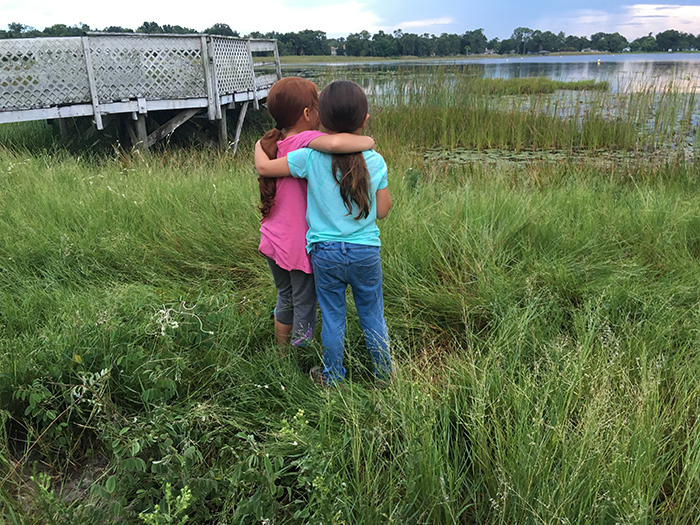
“Non-actors are often free of the showiness, egotism, arrogance, and strut that actors sometimes fall prey to. I tried to learn from them, be like them, fit in their world, and pass. Sometimes it actually makes the scenes more mysterious and compelling because you have to approach them with a ‘beginner’s mind’ and not simply apply a craft to a design. You are forced to reinvent your process, which is something I always welcome,” says Dafoe. Dafoe especially worked to define Bobby’s relationship with Halley, who has an unabashed love for freedom he both admires and worries over. “It’s a real love-hate relationship, complex and contradictory,” he observes. “Halley is the problem child, the thorn in his side. But at the same time he has sympathy for her and worries about her. There are also some traces of moral judgment and some envy – because she’s a free spirit who answers to no one, while his life is all about making amends and taking responsibility. I think he also feels compassion for her and tries to give her a break whenever he can, but he feels so played by her force of personality and manipulation that he’s also very tough on her.” Baker was a constant inspiration. “Sean really invited me to collaborate. He’s a courageous filmmaker, demanding yet soft spoken, gentle and receptive. His aesthetic of balancing the real with the created taps into what the strength of film is: imagery, poetry, music and event. He’s always searching for the truth.” He hopes audiences will be stirred by the truth of these characters that you might not usually see, but become so inviting. “I think audiences will have fun seeing this
Cinematic realism has come in many different flavors -- from the neorealism that churned in Italy after WWII, characterized by working class themes, non-pro actors and found locations, to the “direct cinema” movement of the 60s with its fly-on-the-wall slices of real life, to the so-called neo-neorealism of stripped-down indie American cinema in the new millennium. But Baker’s style blurs the lines between realism and a pop art sensibility that elevates the mundane into the spectacular. Once, a critic dubbed Baker’s style “pop verité” and it’s a name he likes. “The style of The Florida Project is definitely based in realism but it is slightly heightened. We subtly accentuate colors and sounds to emulate the heightened senses of youth,” he says. Baker’s previous film, Tangerine, was shot on an iPhone but on this film he did a 180, bringing in awardwinning Mexican cinematographer Alexis Zabé to shoot on celluloid. Named one of Variety’s “10 Cinematographers To Watch,” Zabé is perhaps best known in the U.S. for shooting Pharrell’s infectious video for “Happy,” but is equally renowned to cineastes for Carlos Reygadas’ Silent Light and Post Tenebras Lux. “I love his naturalistic lighting and framing choices,” says Baker.
To get to know each other, the two collaborated first on a short created for the Kenzo spring line shot in the famed Slab City trailer park. “I knew I wanted to shoot anamorphic 35mm for this film and Alexis was not only experienced with this medium but had a very unique and sophisticated approach. We shot the fashion film together to test the waters and things went swimmingly. He then agreed to sign on to The Florida Project.” Zabé describes the look he was after in one simple phrase: “blueberry ice cream with a sour twist.” Sums up Baker: “I love that Alexis had the instinct from the very start to look for the beauty and warmth in each scene. It would have been so easy to make this a cold film because of the subject matter, but positivity shines through in his cinematography. He nailed the youthful nature of the kids.”
The Florida Project’s use of the local landscape, with its blend of tropical flora and plastic exotica, only adds to the atmosphere. “Some of the credit must be given to Florida itself. There is a Floridian palette and a kind of light there that is undeniable. The pinks, greens and purples seemed to be everywhere,” muses Baker.
Baker retired to the editing room with the footage himself – he serves as editor on all his films. “For my work, editing is 50% of directing,” he elucidates. “Because there is improvisation in front of as well as behind the camera, I like to be the one deciding what works. It gives the film my signature. I like to jump right into a fine cut and skip the assemblage and rough-cut stages. I will completely edit a scene and do preliminary sound design before moving on to the next scene because the style of one scene can dictate
the style of the next.” One key choice Baker made was to bookend his film with two versions of Kool & The Gang’s anthem “Celebration,” which seemed right in tune with Moonee’s spirit, if not her situation. “I’m so happy that Kool & the Gang granted us permission to use their iconic song,” says Baker. Celebration and a pendulum of emotions broke out when the film first premiered at the 2017 Cannes Film Festival, gratifying a cast and crew who had come to love their characters like a family. Recalls Vinaite: “When they turned the lights up at Cannes, I was crying and literally every person in my row was crying. It was so powerful to see how much the film truly touched people. Honestly, I think that will always be the best day of the rest of my life. I’m so thankful Sean has put this story out into the world.”

WILLEM DAFOE (Bobby) is a two-time Academy Award® nominee who has performed in over 100 films including Spider-Man, The English Patient, Finding Nemo, Clear and Present Danger and Mississippi Burning. In addition to his Oscar® nominations for Platoon and Shadow of the Vampire, Dafoe is Golden Globe® nominee for his performance in Shadow of the Vampire which also earned him a LA Film Critics Award and an Independent Spirit Award. Dafoe is a founding member of The Wooster Group, an experimental theatre collective in which he created and performed in all of the group's work from 1977 to 2005. Dafoe selects projects based on the diversity of roles and opportunities to work with strong directors such as Wes Anderson, Martin Scorsese, Spike Lee, Oliver Stone, Zhang Yimou, David Lynch, Werner Herzog and Kenneth Branagh. Another upcoming is James Wan’s Aquaman.
BRIA VINAITE (Halley) was born in Lithuania and moved to Brooklyn, NY when she was 6 years old. Always interested in creative projects, she started designing clothes at 19 leading to the launch of her company 'ChroniCal NYC’ with her hand-making most of the items herself. Her clothes have been worn by all sorts of creatives in different fields. Sean Baker discovered Vinaite on Instagram late in The Florida Project casting process and, as Vinaite puts it, "the rest was magic.” BROOKLYNN KIMBERLY PRINCE (Moonee) booked her first acting job at the age of three and has been hooked ever since! She can be seen on projects both nationally and internationally including spots for Disney Junior, Chuck E Cheese, Honda and Visit Orlando. Brooklynn loves all things Star Wars, Harry Potter and Wonder Woman. She had the time of her life working on The Florida Project with the director she refers to as "Mr. Sean," whom she describes as "one of her favorite people." She is happiest when on set and hopes in the future to work with her favorite actress - Daisy Ridley... oh, and to win an Oscar of course. 6-year-old Kissimmee, Florida native VALERIA COTTO (Jancey) has always wanted to act and was thrilled when she was given the opportunity by Sean Baker to star in The Florida Project. Valeria is a lover of all things Pokemon, is obsessed with J-Pop and is super-excited to see herself on the big screen for the first time. Florida native CHRISTOPHER RIVERA (Scooty) has spent the majority of his nine years growing up in motels similar to his character in The Florida Project. He always dreamed of being in movies and his wishes came true after answering a local casting call. Christopher loves to play video games and is looking forward to seeing his portrayal of the mischievous Scooty on the big screen.
One of Hollywood’s top emerging young actors, CALEB LANDRY JONES (Jack) will next be seen in Doug Liman’s American Made opposite Tom Cruise as well as Martin McDonagh’s Three Billboards Outside Ebbing, Missouri. Caleb starred in Brandon Cronenberg’s Antiviral, which premiered at the Cannes festival and was released by IFC Films, his performance cited among the “Best Performances of 2012” by Indiewire. He co-starred in Joshua and Benny Safdie's Heaven Knows What (awarded the Tokyo Grand Prix at the Tokyo International Film Festival after premiering in Venice), Queen and Country for director John Boorman (premiered at the 2014 Cannes Film Festival), John Slattery's directorial debut, God’s Pocket with Philip Seymour Hoffman, Neil Jordan’s Byzantium (IFC), Fox’s X Men: First Class, Universal’s Contraband and Jordan Peele’s hit directorial debut Get Out. KARREN KARAGULIAN (Narek) is no stranger to independent film. Having been a staple in every feature directed by Sean Baker - Four Letter Words, Take Out, Prince of Broadway, Starlet (for which he won a Robert Altman Award at Independent Spirit Awards as part of ensemble cast) and Tangerine. Karagulian's "every-man" persona spans more than a decade.
SEAN BAKER (Director/Co-Writer /Producer/Editor) is a New York native and graduate of NYU's Tisch School of the Arts. He is an award-winning writer/director known for Take Out (2004), Prince Of Broadway (2008), Starlet (2012) and Tangerine (2015). Sean’s latest feature, The Florida Project, premiered at Cannes — Director’s Fortnight 2017. The Florida Project was acquired by A24 for theatrical and home entertainment release. Baker is also the co-creator of the long-running comedy show Greg the Bunny which had incarnations on IFC TV, FOX and MTV. ANDREW DUNCAN and ALEX SAKS (Producers)/June Pictures: June Pictures is a filmmaker-driven independent production company founded in 2016 by Chairman Andrew Duncan and CEO Alex Saks which produces and finances feature-length narrative and documentary films. June Pictures’ Joshua: Teenager vs. Super Power won the Audience Award in the World Cinema Documentary category at 2017’s Sundance Film Festival and sold to Netflix. Other recent sales at Sundance include the psychological thriller Thoroughbred starring Olivia Cooke, Anya Taylor-Joy, and Anton Yelchin to Focus Features; and Alethea Jones’ Fun Mom Dinner which went to Netflix and eOne’s Momentum Pictures. At Cannes this year, June Pictures was honored by Variety when it placed both Andrew and Alex on its annual “10 Producers to Watch” list for 2017.
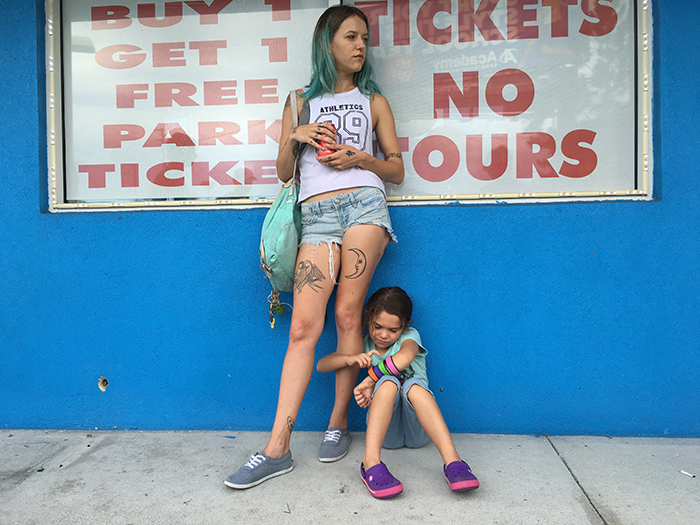
In addition to Sean Baker’s The Florida Project, June Pictures’ “coming soon” list includes: Book Club, starring Diane Keaton, Jane Fonda, Candice Bergen, Mary Steenburgen, Andy Garcia, Don Johnson, Craig T. Nelson, and Richard Dreyfuss; What They Had written and directed by Elizabeth Chomko, and starring Hilary Swank, Michael Shannon, and Blythe Danner; Paul Dano’s directorial debut, Wildlife, starring Jake Gyllenhaal and Carey Mulligan; and the dramatic comedy Dude, written and directed by Olivia Milch, and starring Lucy Hale, Kathryn Prescott, Alexandra Shipp, and Awkwafina.
CHRIS BERGOCH (Co-Writer, Producer) collaborated on the American TV series Greg the Bunny along with its MTV spinoff Warren the Ape. Bergoch is Co-Writer /associate producer of the award-winning Starlet (including the Robert Altman Independent Spirit Award) released in North American theaters by Music Box Films. Bergoch co-wrote/ co-produced 2015’s Tangerine (22 wins/33 nominations, including Best Original Screenplay by the San Francisco Film Critics Circle) and produced the acclaimed 2016 fashion film Snowbird (nominated for direction, original music, major brand, best film, Berlin Fashion Film Awards). Chris is excited to have re-teamed with Sean Baker once again to realize the dream of bringing their Florida Project to the screen.
KEVIN CHINOY and FRANCESCA SILVESTRI (Producers)/ FREESTYLE PICTURE COMPANY: For more than two decades FPC partners Kevin Chinoy and Francesca Silvestri have developed and produced award-winning film, TV, theater and branded content with many of the industry’s most talented individuals and entertainment companies. Their projects have played at major festivals around the world including Sundance, Toronto, Berlin, Locarno, SXSW, LAFF, and Tribeca. Their projects have been represented at award ceremonies including the WGA, DGA, and Independent Spirit Awards. At the top of their long list of collaborators stands Sean Baker, with whom they also partnered on his previous films, Starlet and Tangerine, and the various versions of TV show The Greg the Bunny Show.
SHIH-CHING TSOU (Producer) is a New York City-based filmmaker. Shih-Ching co-wrote, co-directed and co-produced Take Out with Sean Baker, which was nominated for John Cassavetes Award at the 2009 Independent Spirit Awards. After their collaboration on Take Out, Shih- Ching executive-produced Baker’s third feature Starlet, winner of the Robert Altman Spirit Award in 2013. She produced Baker’s fourth feature Tangerine, which was released in the US by Magnolia Pictures in 2015.
ALEXIS ZABÉ (Director of Photography) was born in Mexico City. He has worked worldwide on commercials and music videos collaborating with the likes of Pharrell Williams and Die Antwoord and has paired up on long and short format films with directors Carlos Reygadas and Harmony Korine. His feature work has led to several international awards. The Florida Project marks Zabé’s second collaboration with Sean Baker following the 2016 short film Snowbird, produced for Kenzo.
During the Deauville American Film Festival in 2015 we had the great opportunity to make a nice Sean Baker’s interview:
Synopsis:
Set during the summer, Moonee, a precocious 6-year-old girl, lives with her mother Halley in a community of extended-stay motel guests in pastel-streaked Kissimmee, Florida.
The Florida Project
Directed by Sean Baker
Produced by Sean Baker, Chris Bergoch, Kevin Chinoy, Andrew Duncan, Alex Saks, Francesca Silvestri, Shih-Ching Tsou
Written by Sean Baker, Chris Bergoch
Starring Willem Dafoe, Brooklynn Kimberly Prince, Bria Vinaite, Valeria Cotto, Christopher Rivera, Caleb Landry Jones
Cinematography : Alexis Zabe
Edited by Sean Baker
Production company : Cre Film, Freestyle Picture Company, Cinereach, June Pictures
Distributed by A24
Release date : October 6, 2017 (United States)
Running time : 115 minutes
(Source: press release)

